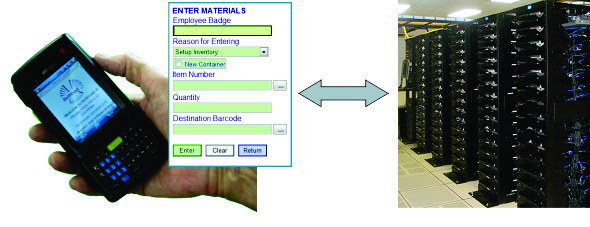
|
Software + Services + Expertise |

|

One of the big benefits of using a web-based technology is that we can minimize user training through the use of web forms. Most employees are very familiar with filling in a form on a website from ordering products and services on-line. So, in the tracking system user interface we mimic the use of this familiar interface.
The problem with using a forms-based interface for operations tracking is that, if we had a box for every possible option they could enter, we would require a large number of data entry boxes, which would be very confusing and mistake prone. Also it is impossible to display all these entries on a mobile device screen, without extensive scrolling. So, instead, we use what we call Magic Forms.
When a user starts entering data, we only present a small number of data entry boxes. Every time the user enters a data field this is sent back to the server and checked against the contents of the database, so the user can be given an immediate warning if they are making a data entry or operational mistake.
If the entry checks OK then the form is reformatted, based on what was entered in the data field. Then the data entry focus is automatically moved to the next box into which data is to be entered. In this way, the familiar form-based data entry paradigm is retained but the form changes dynamically as the user enters data. Only a minimum set of data entry boxes is displayed and the user is led step-by-step through the data entry process.
Once all the boxes are filled in, the user can select a "submit" button and have all the data in the form saved away in the tracking system database. But, up to that time, they can change the data as much as they want, with the form adjusting to accommodate the changes made by the user.
When the submit button is pressed, all the data is checked once again before being stored away to ensure that bad data does not get into the tracking database. Then the user is presented with the data entry screen, just as they submitted it, so they know what they submitted and can then use the previously entered data as the basis for more data entry.
This is especially useful, for example, when entering a sequence of similar containers of a product into inventory where the use of Magic Forms minimizes the amount of manual data entry needed. Magic Forms are also set up so that the data entry into any field can be performed using a barcode scanner. They also encompass the ability to gather weights from weighing scales and to print out barcode labels, in user specified formats, on-demand on bench top or mobile barcode label printers.
The data to be collected and the error checking is based upon rules and parameters setup in the tracking system knowledge base. This enables the data entry screens to be configured to meet a wide range of user requirements without customization.
Also clients can specify rules about when to collect additional data and how to check its validity. This further reduces the need for any customization of the software to collect specific data.
| About KnarrTek | Technology |

|
Services | Cost Savings |
| Copyright © KnarrTek Inc. 2024 |
| Technology |

|
Services |
| About KnarrTek | Copyright © KnarrTek Inc. 2024 | Cost Savings |
Please click here to return to the BellHawk Architecture page